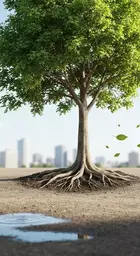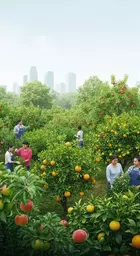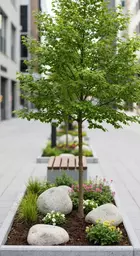Spring
- Leaf Spots
- Wilting
Subscribe to get expert tips and the latest insights on tree care and urban greening directly to your inbox.
Posted on: 2025-07-19
By: Keira Vallejo
Our urban landscapes rely heavily on the health of our trees, which play a vital role in enhancing air quality and the overall beauty of our communities. Understanding seasonal tree diseases can significantly improve our ability to care for these essential components of our ecosystem. By recognizing the signs of disease early, we can take proactive measures to protect our trees and support urban biodiversity.
Observing symptoms of tree diseases across seasons can aid in early detection and prevention. Below is a summary of key symptoms to look for in each season.
As a passionate advocate for urban forestry, I know how vital it is to keep our trees healthy! Understanding seasonal tree diseases is crucial for ensuring the wellbeing of our city landscapes. When we identify these diseases early, we can take proactive steps to manage and prevent further damage, creating a greener, healthier environment for all.
But why is it so important to recognize tree diseases? Well, trees play a significant role in our urban ecosystem, providing shade, improving air quality, and enhancing our overall quality of life. By learning to spot issues, we not only protect our beloved trees but also contribute to the vitality of our communities. It's also important to consider the urban trees and mental well-being, showcasing a holistic approach to urban health.
The first step in caring for our urban trees is recognizing the signs of disease. Early identification can make all the difference! With a keen eye, we can monitor our trees for unusual changes, which often serve as indicators of underlying health problems.
When we take the time to educate ourselves on tree diseases, we empower ourselves and our communities to act effectively. This knowledge not only enhances our urban canopy but also strengthens the bond between residents and their environment!
Different seasons bring diverse challenges for tree health. Understanding these seasonal influences helps us prepare and respond accordingly. Here’s a quick look at the primary causes of tree diseases throughout the year:
As the seasons shift, so do the threats our trees face. By recognizing these seasonal patterns, we can adopt preventive measures and ensure our green friends thrive year-round. For more information on seasonal care, check out this seasonal urban tree care guide.
Plant pathology is the study of diseases in plants, including our urban trees. Understanding this field is essential for effective tree care. It helps us identify pathogens and understand how they interact with tree species, leading to effective treatment strategies.
Here’s why plant pathology matters:
As an urban forestry expert, I encourage everyone to delve into the fascinating world of plant pathology! By doing so, we can become more effective stewards of our city’s trees and promote healthier urban ecosystems together.
Here's a brief recap of the key points discussed so far:
Being able to identify tree diseases is essential for maintaining healthy urban landscapes. Just like us, trees can show signs of stress and illness during different times of the year. By understanding how to recognize these symptoms, you can take action quickly to protect your urban greenspace. Let’s dive into the symptoms you might see across the seasons!
Observing your trees regularly makes a big difference. Whether you're enjoying a stroll or sipping coffee in the garden, keep an eye out for changes in leaves, bark, and overall health. Noticing these symptoms early helps ensure your trees flourish, bringing life and beauty to your neighborhood.
Spring is a time of renewal, but it can also be when some tree diseases make their appearance. One of the first signs to watch for are leaf spots. These can be caused by fungi or bacteria, and they often start as small, discolored areas on the leaves.
Another symptom to look out for during this season is wilting. If your trees' leaves appear droopy or shriveled, it could be due to a lack of water or underlying disease. Make sure to check the soil moisture and consider a more in-depth inspection if problems persist. If you are concerned about your trees' health, consider the assessing urban tree health guide for ways to proactively manage their wellbeing.
As the temperatures rise, so do the signs of tree distress. One common issue during summer is bark cankers, which appear as sunken areas on the bark. These cankers may ooze sap and are often caused by environmental stress or fungal infections.
Pest infestations also tend to peak in summer. Look for signs like holes in leaves or sticky residue on the branches. Pests such as aphids and beetles can wreak havoc on your trees if not addressed in time!
In autumn, trees prepare for dormancy, but symptoms of distress can still show up. You might notice discoloration in leaves that doesn’t look like normal fall color changes. A yellowing or browning of leaves can indicate nutrient deficiencies or disease.
Additionally, keep an eye on your trees’ roots! Root rot can occur when soil is too wet, leading to a loss of vigor in your trees. If your trees are suddenly losing leaves or looking unhealthy, it’s time to assess the root zone.
Winter is a unique time for tree health. While many trees appear dormant, it’s vital to watch for signs of disease. During this season, you might not see active symptoms, but checking for cracks or peeling bark can reveal underlying problems. It's also beneficial to consider benefits of professional tree care to ensure your trees are well-maintained.
In addition, pay attention to any unusual growths or changes in bark texture. Winter can be a quiet time, but it’s the perfect opportunity to prepare for the coming seasons!
Fungal infections can affect trees across all seasons, but some, like powdery mildew and anthracnose, are particularly common in spring and summer. Powdery mildew appears as a white, powdery substance on leaves, while anthracnose causes dark, sunken spots.
Both of these issues can weaken your trees if not properly managed. Ensuring good air circulation and avoiding overcrowding can help minimize these infections.
Bacterial infections can be just as harmful as fungal ones. Symptoms might include gummosis, where trees ooze a sticky substance, or leaf spots that appear wet and dark. Recognizing these symptoms early can help you address the problem quickly.
Keeping your urban canopy healthy requires vigilance! Regular checks for these bacterial signs can save your trees from serious damage down the line.
Here is a quick recap of the important points discussed in the article:

 As urban environments evolve, the resilience of trees becomes increasingly critical in combating cli
As urban environments evolve, the resilience of trees becomes increasingly critical in combating cli
 What if the key to combating urban food insecurity lies in our own backyards? Urban fruit trees not
What if the key to combating urban food insecurity lies in our own backyards? Urban fruit trees not
 Urban environments are often described as concrete jungles, but they can also be vibrant ecosystems
Urban environments are often described as concrete jungles, but they can also be vibrant ecosystems